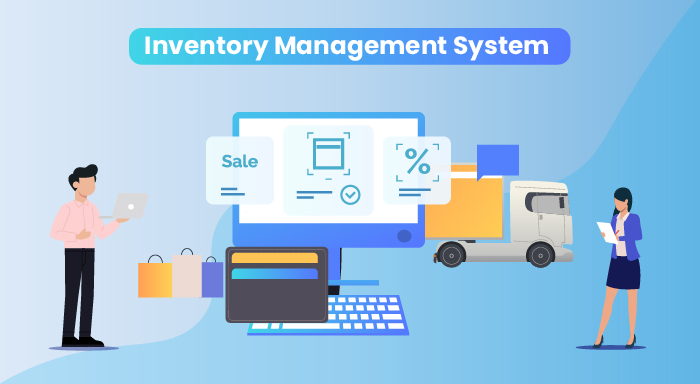The business of your heating, ventilation, and air conditioning must look forward a high-quality service instead of searching for part and tools.
Managing inventory is a crucial aspect of success for HVAC businesses. Why? Because properly managing inventory ensures that products are available when needed, it saves you from chaos and streamlines operations, and most importantly, it maximizes profitability. HVAC Inventory Management Software can also provide predictive analytics that helps managers make better decisions about their inventory and purchasing strategies.
In this blog post, we’ll dive into how HVAC businesses should select their inventory management system to elevate their operations to the next level. Choosing the right HVAC business software can significantly streamline inventory tracking, reduce costs, and boost service efficiency.
Essential Features for HVAC Inventory Management Systems
Barcode Scanning
First and foremost feature to choose is the barcode scanning in an inventory management system.
The technology added to a system significantly improves accuracy and ease up the process of tracking inventory. By using barcode scanning, technicians can quickly scan any equipment and add it to the inventory. They can also input and retrieve information about tools, minimizing errors associated with manual data entry.
By implementing the process of barcode scanning you are allows to reduce the risk of errors making and will also enhance the operational efficiency.
You can print barcode or QR code labels for assemblies and parts using The QR Code Generator (TQRCG) to know where your inventory is placed in the warehouse.
Multi-location Support
Many HVAC businesses operate in multiple locations, such as different service centers or diverse project sites. For that, an effective inventory management system should offer robust multi-location support. This feature ensures that businesses can accurately track their inventory across various sites, preventing overstocking or stock outs.
The ability to manage inventory across multiple locations simplifies workflows and provides a comprehensive view of stock levels at all sites. This centralized control prevents discrepancies, facilitates better coordination, and optimizes inventory distribution. In the competitive landscape of HVAC services, having a system that supports multi-location management is a win-win, and IndusTrack is one of those efficient inventory management software that handles all your inventory related issues so, you can always focus on bringing more business.
Real-Time Tracking
Having up-to-the-minute visibility into inventory levels enables businesses to make informed decisions promptly. This feature is especially crucial for HVAC businesses dealing with perishable goods or time-sensitive projects.
Real-time tracking prevents delays by allowing businesses to respond quickly to changes in demand or unexpected events. This proactive approach ensures optimal stock levels, minimizes wastage, and enhances overall project efficiency. Choose an inventory management software that traces inventory from estimates to jobs and to invoices so you always know where your stock lies. If your software has the ability to reserve inventory during the estimates, you can ensure parts' availability, and hence never face stock outs at the time of job.
Mobile Accessibility
An inventory management system that offers mobile accessibility empowers HVAC technicians to manage inventory on the go. With a dedicated mobile app, technicians can easily add or update inventory information directly from the field.
Mobile accessibility not only saves time but also adds to the flexibility. Technicians can access real-time inventory data, update stock levels, and manage work orders efficiently, all from their mobile devices. This feature ensures that technicians have the most accurate and current information at their fingertips, contributing to improved overall service delivery.
Reporting and Analytics
A robust reporting and analytics feature in an inventory management system provides valuable insights into inventory trends, stock turnover, and other key performance indicators.
By analyzing this data, businesses can identify areas for improvement, optimize stocking levels, and reduce carrying costs.The process of reporting and analytics will enhance your decision making, assist business in adapting changing trend, and operational efficiency as well.
Regular reports can highlight patterns, forecast demand, and guide inventory planning, contributing to a more proactive and efficient approach to inventory management.
In addition, analytics tools can provide a deeper understanding of product performance, supplier reliability, and overall inventory health. This comprehensive view allows businesses to make data-driven decisions, ultimately contributing to better resource allocation and improved bottom-line results.
Customization
A valuable feature in an inventory management system for HVAC businesses is customization. Every business has unique needs, and a system that allows customization can adapt to specific requirements. This might include tailoring fields, labels, or workflows to match the terminology and processes used within the HVAC industry. Customization ensures that the system aligns seamlessly with the business's existing practices, reducing the learning curve for employees and promoting user adoption.
Scalability
As HVAC businesses grow, so do their inventory management needs. A scalable system can accommodate an expanding inventory, additional service locations, and a growing workforce.The adaptability of this approach will not only help you in giving a long term success but also will prevent the need of a system overhaul for business evolving.
Scalable inventory management systems often offer modular structures, allowing businesses to add functionalities as needed. This flexibility ensures that the system can grow alongside the business, providing a future-proof solution that supports expansion without compromising efficiency.
Integration with Other Systems
An effective inventory management system should seamlessly integrate with other business systems, such as accounting software like QuickBooks. Integration streamlines processes by eliminating manual data entry and reducing the risk of errors.
For HVAC businesses, integrating inventory management with accounting software ensures accurate financial records, facilitates invoicing, and enhances overall financial management. CRM integration enables a unified view of customer interactions, allowing businesses to align inventory levels with customer demand more effectively. Procurement system integration streamlines the ordering process, improving efficiency in managing supplier relationships.
Stop wasting time and money tracking down essential HVAC parts and tools.
You’re in the business of helping your customers and fast. Last but not least thing you make sure that your technician must have the skills to do their job without having the required part or tools. Apart from this, ensure that your team members are offering the excellent and on-the-spot services along with the essential tools.
In conclusion, the selection of an inventory management system for HVAC businesses requires careful consideration of a variety of factors.
By prioritizing these features, HVAC businesses can ensure that the chosen system not only meets their current needs but also grows alongside the business. This all-exclusive approach of inventory management system selection helps in improving the effectiveness, reduce cost, enhance the chances of long-term success in the competitive HVAC industry.
As businesses continue to evolve, having the right inventory management system in place becomes a strategic advantage that enhances overall operational excellence and customer satisfaction.



